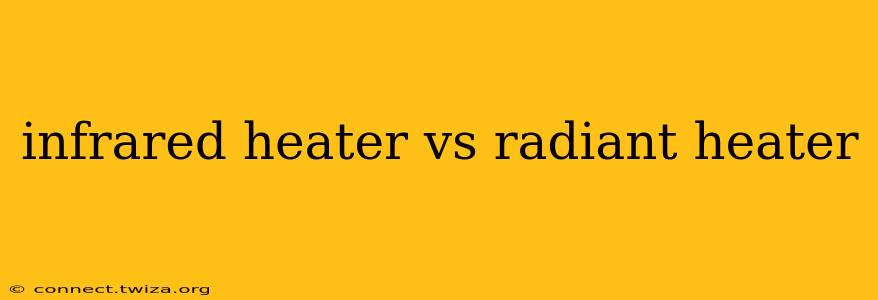The terms "infrared heater" and "radiant heater" are often used interchangeably, leading to confusion. While all infrared heaters are radiant heaters, not all radiant heaters are infrared heaters. Understanding the subtle yet crucial differences is key to choosing the right heater for your needs. This comprehensive guide will delve into the specifics, answering common questions and clarifying the distinctions between these two heating technologies.
What is a Radiant Heater?
A radiant heater warms objects directly, not the air. Think of the sun; it doesn't heat the air significantly, but it warms you directly through radiation. Radiant heaters achieve this by emitting electromagnetic waves, which transfer heat to anything they encounter. This type of heat feels more natural and comfortable than forced-air heating because it warms you directly rather than just warming the air around you.
What is an Infrared Heater?
Infrared (IR) heaters are a type of radiant heater. They specifically use infrared radiation to transfer heat. Infrared radiation is part of the electromagnetic spectrum, invisible to the human eye but felt as heat. Different wavelengths of infrared radiation have varying heating properties, influencing the effectiveness and application of the heater. Short-wave infrared heaters heat up quickly and are suitable for larger spaces, while long-wave infrared heaters provide gentler, more localized heat.
How do Infrared Heaters Work?
Infrared heaters generate heat by passing an electric current through a heating element. This element emits infrared radiation, which then travels in straight lines until it hits an object. The object absorbs this radiation and converts it into heat. Because the heat is transferred directly, it's efficient, even in well-ventilated areas, unlike convection heaters that rely on heating the air.
What are the Different Types of Infrared Heaters?
Several types of infrared heaters exist, each with its own advantages and disadvantages:
- Electric Infrared Heaters: These are the most common type, using electricity to heat a filament or ceramic plate that then emits infrared radiation. They are relatively inexpensive and easy to install.
- Gas Infrared Heaters: These use natural gas or propane to generate heat and emit infrared radiation. They are typically more powerful than electric models but require a gas line connection.
Are Infrared Heaters More Efficient Than Other Radiant Heaters?
Infrared heaters can be more efficient than other radiant heaters, but this is not always the case. Their efficiency depends on factors like the wavelength of infrared radiation emitted, the reflectivity of the surfaces in the heated space, and the overall design of the heater. While they don't heat the air directly, resulting in less energy loss through convection, their efficiency is still impacted by these variables.
What are the Advantages of Infrared Heaters?
- Direct Heat: Offers immediate warmth to people and objects, not just the surrounding air.
- Energy Efficiency (Potentially): Can be highly efficient in specific applications, particularly when heating targeted areas.
- Quiet Operation: Unlike forced-air heaters, they are typically very quiet.
- Easy Installation: Many models are portable and require minimal installation.
What are the Disadvantages of Infrared Heaters?
- Localized Heating: Can create hot and cold spots if not strategically placed.
- Potential Skin Burns: Prolonged exposure to high-intensity infrared radiation can cause skin burns. Always maintain a safe distance.
- Cost: While some are inexpensive, high-quality models can be costly.
- Type Dependence: Different types of infrared heaters have different efficiency levels and maintenance requirements.
What are the Advantages of Radiant Heaters in General?
- Comfortable Heat: The direct heat feels more natural and pleasant compared to forced-air systems.
- Targeted Heating: Allows focusing heat on specific areas, reducing energy waste.
- Low Air Circulation: Doesn't stir up dust and allergens as much as forced-air systems.
What are the Disadvantages of Radiant Heaters in General?
- Uneven Heat Distribution: Can cause uneven heating in a room if not correctly positioned.
- Initial Cost: Can be more expensive upfront than some other heating systems.
In conclusion, while all infrared heaters are radiant heaters, not all radiant heaters utilize infrared technology. The best choice depends on your specific needs, budget, and the space you intend to heat. Consider the advantages and disadvantages of each type before making your decision. Remember to always follow manufacturer's safety guidelines when using any type of heater.
